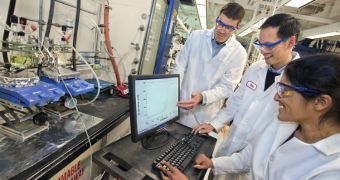A group of scientists has recently developed a new method for producing hydrogen out of water. As the most abundant natural resource on the planet, water can be used for a variety of purposes, albeit only if it's broken down into its basic components, hydrogen and oxygen. In the new experiments, experts managed to devise a new catalyst for extracting hydrogen from water. The chemical holds tremendous promise for the renewable energy industry of tomorrow, as it can be used in fuel cells, as rocket fuel, and for a variety of other applications as well.
Physicists and chemists from the US Department of Energy's (DOE) Lawrence Berkeley National Laboratory (Berkeley Lab), working in collaboration with colleagues from the University of California in Berkeley (UCB), managed to produce the new catalyst. The only obstacle that stands in the way of applying hydrogen to various industries on the large scale is the fact that current production methods are very cost-intensive and time-consuming. With the aid of the new technique, obtaining the precious chemical could become easier, and also carbon-neutral, the group says.
“Our new proton reduction catalyst is based on a molybdenum-oxo metal complex that is about 70 times cheaper than platinum, today’s most widely used metal catalyst for splitting the water molecule. In addition, our catalyst does not require organic additives, and can operate in neutral water, even if it is dirty, and can operate in sea water, the most abundant source of hydrogen on earth and a natural electrolyte. These qualities make our catalyst ideal for renewable energy and sustainable chemistry,” explains Berkeley Lab Chemical Sciences Division scientist Hemamala Karunadasa, who also holds an appointment at the UCB Chemistry Department.
She is one of the discoverers of the new metallic catalyst and also the lead author of a new study detailing the findings, which appears in the April 29 issue of the esteemed scientific journal Nature. The research is entitled “A molecular molybdenum-oxo catalyst for generating hydrogen from water.” Other coauthors of the study include Berkeley Lab/UCB experts Christopher Chang and Jeffrey Long.
“The basic scientific challenge has been to create earth-abundant molecular systems that produce hydrogen from water with high catalytic activity and stability. We believe our discovery of a molecular molybdenum-oxo catalyst for generating hydrogen from water without the use of additional acids or organic co-solvents establishes a new chemical paradigm for creating reduction catalysts that are highly active and robust in aqueous media,” Chang concludes. The research was sponsored in part by the DOE Office of Science, through the Helios Solar Energy Research Center, and in part by a grant from the US National science Foundation (NSF).

 14 DAY TRIAL //
14 DAY TRIAL //